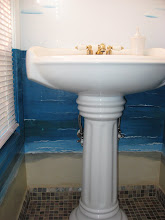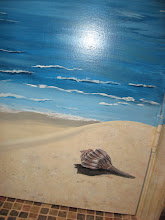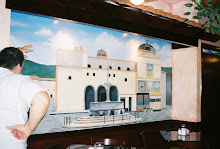Tuesday, March 11, 2008
Choosing The Right Colors For Your Home - I've Made it Easy
When I go into a home for a color consultation, I try to get to know my clients before I suggest any particular colors. For instance, are they energetic? Do they wear bold colors? Are they quiet and shy? If I went into their closet what would I find? These answers tell me a lot about their personalities and usually what they would like in their home. You should ask yourself the same questions. If you are energetic and bold, you may have an interest in colors as reds, yellows, purples, and royal blues. If you are quieter, soft greens, blues, pinks, creams are more your style.
It’s all about creating an environment that makes you want to come home to a safe haven. This is where you can plop down and be at your most relaxed and comfortable state.
So, the question is “how do I begin?” I begin with a color plan in which I start with the “givens”; the existing upholstery/furniture fabrics that you have, art work that may be on the walls, window covering fabrics, area rugs, flooring materials, cabinet and countertop colors and anything else that is staying in place that would have a contributing factor to choosing your colors.
From those existing fabrics, art work, or rugs, pick two colors that you just generally gravitate toward and enjoy seeing that will now be your base colors. Then pick your “passion or hot color” from those fabrics to be your accent color. This “hot” color is usually red, burgundy, deep rust or something similar. Your accent color is extremely important to give your home “life” or “excitement”. It will only be used in small doses as an accent, usually two to three times disbursed throughout the room. Now you have your color plan that you will use through the majority of your home. Bedrooms are the exception and can have their own entirely different color plans based upon the occupants desires.
You will use these colors in varying shades of lights and darks to give contrast. Interior design is all about creating interest. Interest is derived from contrasts. Light vs. dark, shiny vs. dull, texture vs. smooth, pattern vs. solid, just to name a few. These colors will be utilized throughout all your fabrics, art, rugs and accessories. Your accent color is the bright flower in a fabric or used in an accent like a candle or floral arrangement.
Keeping this unifying color plan will enable your home to flow freely from room to room. By using the varying shades of colors and accent color, this will give your room that wonderful feeling of warmth and interest in your home. Your wall colors are another subject entirely. Look for my next article on “Choosing the Right Wall Colors for You”.
About Author:
Sheri Falcone is a novice author, student of personal growth, interior designer and entrepreneur who enjoys helping others achieve their dreams, be it their homes or building financial freedom with her personal development business, www.setnolimits.info. Her enthusiasm is contagious and she believes laughter and appreciation are our emotional healers. If you live in San Diego and would like a color consultation, please call 858 577-0025.
Article Source: http://www.articleblotter.com/
Feature Video:
The Smartest Way to Choose Paint Colors for Your Home!
Choosing paint colors for your walls is not an easy task. With Tru-Hue Paint Test Boards, you can avoid making costly color mistakes and choose the right color every time ! Tru- Hue
WallDreams brings you information you can use - when doing it yourself is the only way to go!
Monday, March 10, 2008
Taupe -- A New Neutral and Tricky Wall Color
In response to customer demands, many paint companies have come up with shades of taupe. Behr paint, for example, has its White and Light Collection. This collection includes shades of taupe that go from Parisian Taupe, to Indulgent Mocha, to Pale Bamboo. Some shades have more brown in them, while others have more pink.
Glidden also produces various taupe colors and, like all paint companies, the colors have fantastic names like Meditative Moment and Bistro Beige. As descriptive as the names are, they may not help with your color choice. How can you find a shade that works for you?
Find the brightest spot in the store and look at a color swatch. Flourescent lighting changes colors, so take the chip outside and look at the color again. Bringing fabric and carpet swatches will also help you find the right shade. Buy a small can of paint and try it on a small section of wall. Since changing light changes the color, look at your sample paint job during the day, at dusk, and at night.
Your paint homework may not keep you from disappointment. The Home and Garden TV Web site has a message board and one home owner pleaded for help. He painted the walls of his renovated bathroom taupe and was dismayed with the result. "Every color I put up against the walls makes taupe come across as slightly mauve," he wrote. The home owner repainted the walls.
The Garden and Hearth Web site discusses taupe in an article titled, "Interior Design Colors: Taupe," by Sarah Van Arsdale. She describes taupe as a neutral color and a good choice for walls, but you have to choose the right taupe. "Be careful not to make a room too dark, " warns Van Arsdale.
A dark shade of taupe will make a small room appear smaller. Taupe also darken angular spaces. While taupe can be the basis of a neutral decorating scheme, Van Arsdale says you don't want your scheme to be bland. Adding textue with pillows and upholstery, plus colorful accessories, will keep this from happening.
Taupe is really a family of colors -- beautiful, rich, adaptive colors that go with all design styles. It's a great color choice if you're planning to move and a great color choice if you're planning to stay. With a little detective work you'll find the right taupe for you.
About Author:
Harriet Hodgson has been a freelance nonfiction writer for 29 years. She is a member of the Association of Healt Care Journalists and the Association for Death Educaiton and Counseling. Her 24th book, "Smiling Through Your Tears: Anticipating Grief," written with Lois Krahn, MD, is available from http://www.amazon.com You will find a review of the book on the American Hospice Foundation Web site and the Health Ministries Association Web site. Copyright 2008 by Harriet Hodgson
Log onto http://www.harriethodgson.com to learn more about this busy author and grandmother.
Article Source: http://EzineArticles.com/
 WallDreams Paint Ideas!
WallDreams Paint Ideas!Live with a color before making a final decision. You may be able to buy a small color sample (available from some paint manufacturers) and paint an inconspicuous wall area or sample board then live with the color for several days. A sample board should be prime base coated in a background as close as possible to the wall you are painting over to get the true color. Look at the sample at different times during the day. Notice how it changes in varying lights. See how it looks with how the rest of the room is decorated. Always remember the best time of day that you will be using the room the most also.
If small paint samples are not available, perhaps buy the smallest amount available to mix of that color, perhaps a quart.
Other colors that are "difficult" to work with as far as coverage and "getting it just right" are yellow and red. Yellow is one tough color, as it usually comes out far brighter than you will be comfortable with. Red can be difficult to work with as far as coverage and coats. A primer tinted in a similar color will help here.
Sunday, March 9, 2008
Applying A Faux Marble Finish To Surfaces
Real marble can be extremely expensive. But with faux painting techniques, you can create the look of marble at a price that you can afford. You don't even need to be a professional painter to get great results!
Getting Started
Spend some time looking at pictures of real marble slabs before beginning your faux painting project. This will help you get a better idea of what will work for your surface. These days you don't even have to travel to do that. Just do a search online for "marble" and you can find websites that give you a variety of pictures. There are a number of different methods used to create the look of marble. However, if this is your first faux painting project, intricate designs may be too much to tackle. Additionally, busy patterns can sometimes compete with other elements in the room. If you are going to apply this finish on a wall, then consider a marble look that has less veins that softly blend into one another. Your colors should match the existing room decor.
Tips for Marble Faux Painting Projects
The popular colors used in marble faux painting projects are burnt sienna or dark grey on a pale ivory background. When creating a faux marble finish, you'll need at least two colors of glaze. If you are working with black background, however, shades of white and green are best.
Adding texture to your base coat of glaze can be achieved by lighting dabbing the area with a balled up plastic grocery bag. Tone variations can be created by lifting off excess paint with a natural sea sponge.
Veins can be added to your work with a fine paintbrush, but you may also want to experiment with the different looks provided by making veins with a goose or turkey feather. If you want to make a stencil to guide your work, tear a strip of poster board and paint along the jagged edge.
Consider spending some time perfecting your technique first, on a sturdy sheet of poster board. However, don't be overly critical when trying to correct mistakes in your work. As a natural material, real marble is seldom perfect. Diverse looking veins in regards to thickness and intensity is important. Therefore, even a few minor mistakes can help give your faux painting project a more realistic appearance.
Working with a Faux Painting Kit
For those who are just learning about faux finishing techniques, investing in a faux painting kit can be a smart move. A kit gives you all of the necessary tools in one convenient location, plus detailed instructions to guide you through your home decor project. Even though many home improvement stores are limited in the variety of kits you might find, the internet is a great place to purchase one right for you. There are websites that show you the basics of faux painting which you can incorporate in achieving a faux marble finish, even if it is not included in the kit.
About Author:
Sandy Silva is a professional Faux Painter and Muralist. Her company, Murals & Faux Painting, Inc. in the Miami area has been in business for 20 years and has been dedicated to the decorative wall painting profession for 10 years now. Buy her DVD workshop which comes with 5 tools....one being patent pending. A separate DVD showing how to achieve 4 different marble finishes will be available soon on her website at http://www.muralsandfauxpainting.com/
Article Source: http://EzineArticles.com/?expert=Sandra_Silva
Happy Painting! - Donna of WallDreams *note: Image is a Faux Marble Shelf - Prospect Hill Plantation Inn, Trevillians, Virginia A good tip is to paint faux marble where you would reasonably find marble in real life such as columns, floors, moldings, mantles, fireplaces, walls or countertops where the cost and wear of the surface would not outweigh the price of the real thing. Contemporary as well as classical and traditional design styles are great choices for marbling.
A good tip is to paint faux marble where you would reasonably find marble in real life such as columns, floors, moldings, mantles, fireplaces, walls or countertops where the cost and wear of the surface would not outweigh the price of the real thing. Contemporary as well as classical and traditional design styles are great choices for marbling.
As marble is a clean, smooth stone, so must the prepared surface be.
Do some research on the many different types of marble and how they look - direction of color options, veining, and patterns so that the final faux finish* rings true. (*say that 3 times fast)
If marbling an entire wall, you may want to break the effect into sections or seams of several "blocks" of marble.
Marbling is a layering effect of color taking time, patience and practice to get optimal results.













